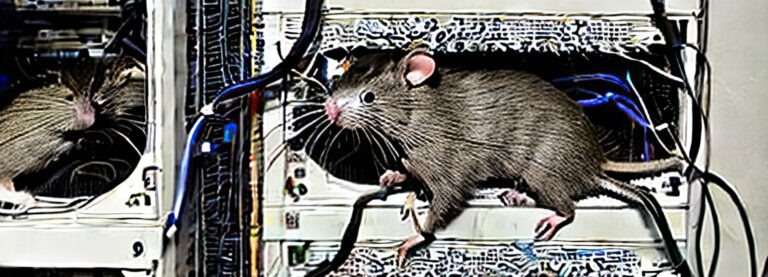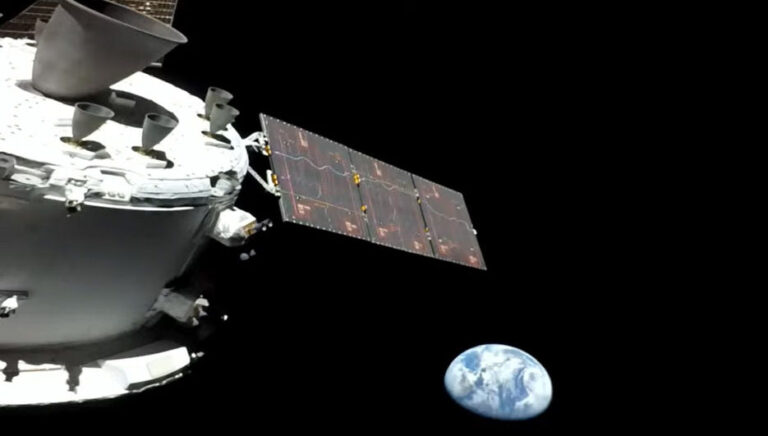For humorous effect and to make somewhat good use of the literary device of irony, I really should start this tale out with the fact that on the evening of Friday, the 19th of April, while I was on the phone with Mark Holtz in Sacramento, I told him that the river deflects just about every tornado from Fort Smith, Arkansas. A quick hailstorm ensued shortly after, and I got off the phone with Mark to go to work. I should’ve known I’d get it for saying such a stupid thing.
But the truth is, until the following Sunday night, the Arkansas River which borders Fort Smith on the west, north and east had sheltered us from virtually every such storm for as long as I have lived. The storms form in southeast and east central Oklahoma, and move east-northeast into Arkansas. Smaller towns have been known to catch untold kinds of hell over the years. Van Buren, to the north of Fort Smith, is separated from this city only by the Arkansas. In decades past, Fort Smith depended on the river for commerce as boats traveled here from the Mississipi River at which the Arkansas terminates. Though naval commerce no longer supports the city, Fort Smith’s residents still owe a lot to the Arkansas River. It’s been a mote that had defended the city from the worst kind of harm. Until now.

Sunday, April 21, 1996
On the night of the 21st, a storm system with a history of spawning tornadoes in southern and southeast Oklahoma marched right up to the border between Arkansas and Oklahoma. Tornado warnings were issued for Sequoyah and LeFlore counties in Oklahoma, which border onto, respectively, Crawford and Sebastian counties in Arkansas…which, respectively, contain Van Buren and Fort Smith.
At about 11:05, I received a call from work. I’d seen some lightning, but other than that, I was kicking back and listening to some music, virtually oblivious to what was going on. Gregg at the TV station said, “You might want to come in, they’re probably fixing to issue a tornado warning for Crawford and Sebastian.” This is not an unusual request in emergency situations; the station is at the east end of the 500 block of Garrison, and my apartment is on the west end of the same block; it was sadly commonplace for the night crew to give me a call at the slightest hiccup.
I wasn’t really presentable, and, figuring that I might have to pass myself off as a weather anchor or something – not what I really do at work, by the way, but I’ve done the weatherman schtick in the past in tight squeezes – I squeezed into my one good outfit of dress clothes, grabbed my tie and my keys, and started to head out the door. Then I turned around and told my two cats that I love them – which I always do before leaving them alone when I have to go to the station in severe weather situations. This may seem like a silly, sentimental thing to do, especially for a guy, but that’s me. My cats are very important to me, being the closest thing I have to family anywhere near Fort Smith. This time that farewell counted.
I locked the door behind me and ran down the back walkway at Old Town at a mere few minutes past 11:00pm. Normally I step very softly, for the back walkway contains the doors to the building owner’s apartment and office, but I ran this time. Rain was pouring outside.
I exited the building from the rear and sprinted across the back parking lot in the downpour. When running, one can cover the distance from my door to the station’s back door in about a minute.
I got to the keyboard on which we type all of our on-air weather warnings when the weather radio sounded its tone. Bill J., who usually relives Gregg in the control room at 11:00, punched the button so we could hear the voice of the weather service. Tornado warning, Crawford, Sebastian. (Time, it seems, is relative. Different TV stations’ news reports have placed the issuance of the tornado warning between 11:06 and 11:10pm, and the weather service’s official reports have the touchdown of the tornado in downtown Fort Smith at 11:15, though it has since been charged that the weather service rewrote the brief history of this storm to cover their own asses since warnings were issued less than a minute before the touchdown of the funnel cloud and the sirens were never sounded.) I started typing the warning in when the lights flickered, came back up. Uninterruptable power supplies bleeped and whistled in protest. Electricity down and back up again. Down and up again. Down…down…down for good. Monitors without a UPS between them and the rest of the world died. The control room went dark. Lightning repeatedly filled the two large plate glass windows in the control room (our station fills the second story – including two ballrooms – of an old retrofitted 11-story hotel). The power was gone. There was a howling outside like nothing I’d ever heard. Something besides rain hitting the windows. It’s not just hail.
Gregg was the first to find a flashlight in the dimming room and yell “Let’s go, guys!” By no means did I heroically lead the charge to safety – in fact, I brought up the rear, barely able to comprehend that it was happening too fast for me to simply type it into a computer. We headed down the sturdy spiral staircase to the first floor in almost total pitch black.
WHAM!
We heard that impact, but didn’t feel it.
I started directing the two – neither of whom had been with the station more than half a year, if even that long – to head down the next flight of stairs to the basement of the building, which is where everyone’s been told to go in the event of a tornado.
Bill J. instead headed for the front doors. Two heavy wooden doors with lots of glass, then two large, heavy glass doors with little wooden handles.
“Look at this, guys!” he said. The wind laughed at him.
WHAM!
We felt it that time. Not like the building being ripped right off its foundations, but more like God giving the building a gentle kick.
Then CRASH!
Bill J. started running back toward us, and stopped to look out the side doors – and noted that the extremely long awning that had stood outside the Broadway Restaurant for several years was now wrapped tightly around the adjacent building to the east. What Bill didn’t know was that the smashing sounds that followed the shuddering of the building were the large windows of the travel agency on the first floor. The shattered debris was separated from us only by an interior set of windows which were none too thick.
It got real quiet.
Bill stood and looked out the side doors for a long time. Finally, he opened the interior wooden doors and then out the glass doors onto the sidewalk.
The city of Fort Smith was nowhere to be seen unless we pointed our solitary flashlight at it.
The wind was still blowing hard, and the rain was still pouring, but our attention was focused on what little we could see of a cloud that seemed to be traveling due north away from us.
When illuminated by the ever-present lightning, that cloud was too damned low. The rain and the darkness made it impossible to tell if it was rotating or not, and did not reveal to us that it was giving the city blocks north of us a kiss. Somewhere in that mess that we couldn’t see clearly, the air had taken it upon itself to attempt to violate the earth. If anyone happened to be in the path of that struggle, their fate was by far more uncertain than it was on even the best of days.
Other flashes of light picked out shorting transformers, downed power lines, houses on fire, and what seemed like the end of everything.
We went back upstairs to survey our floor, and found little damage – amazingly, no windows out, and the UPSs were still bleeping, though their safe charge of a few minutes had worn off and every piece of equipment in the station was silent and dark.
Gregg found another flashlight and we ventured downstairs and out the back door into the parking lot to take a look.
Pieces of roofing seemed to provide the street random patches of extra pavement. The top of an air conditioning unit had come to rest from God knows where, pointing its useless fan upward. The rear window of a company truck parked behind the station had been smashed into countless pieces, and our dumpster had been deposited in a parking lot half a block away.
I told the guys that I was going to go check my home. Nobody tried to stop me.
Though running, I found the sprint back home, in pitch dark, fearing the worst, took several years. I tripped and fumbled up the stairs and felt my way through the back hallway quite clumsily. I could see people standing outside their doors whenever the lightning illuminated the (astonishingly enough, unharmed) skylight, and asked if everyone was okay, more to announce my presence without alarming them than anything. Most of them didn’t know what had happened.
I battled the lock of my front door for at least a minute – normally a one or two second reflexive movement – and opened it. Pitch black, of course. I called out to my cats and then realized that I was doing something incredibly dumb. Normally, when I open the door, they’ll do just about anything to get out and explore, and if they got out now, I’d never find them in the confusion and the dark and lose them forever. I closed the door behind me.
That didn’t help a lot. I was now in the dark, having difficulty breathing, and still couldn’t find my cats. I hadn’t grabbed a flashlight. I finally found my own flashlight in my workroom, turned it on, and it flickered out. Big help. I then realized that I’d be standing on the back of my largest bookcase if I took one more step.
I got around that obstacle and opened the shutters of one of my four south-facing windows, which look out onto Garrison Avenue. All I saw were the lights from the police cars, ambulances and fire trucks, and more lightning. The landlady knocked on the door to see if I was okay, and I wound up commandeering her and her flashlight in an effort to find my cats. I dug the cat carrier out of the closet because I didn’t know if the building was still a viable entity. I found both of the cats, but they went into hiding the moment I tried to shove them into the box. Someone else knocked on the door, looking for the landlady and fearing the worst since they hadn’t found her. Without realizing it and without any sense of the passage of time, I had “borrowed” her for over fifteen minutes in an attempt to find Othello and Iago.
I made one of the hardest decisions I’ve ever made and decided that the cats would be safer if I continued about my business and closed and locked the door to my apartment behind me. Had anything happened to them as a result of that decision, I wouldn’t have been able to live with it. They’re family. This decision would come back to dance with me again in a matter of days, almost as if to drive home the horrible implications of leaving them behind.
I ventured down the front stairs after the landlady and saw my first real glimpse of what had really happened.
The tree that had stood in front of the precise middle of my apartment since long before I had lived there was lying on its side in the middle of the sidewalk, the huge chunk of dirt that it had been planted in ripped out of the ground right along with it. The bricks that formed the planter for that tree were all over the place.
It was obvious that just across 5th Street to the west, the 400 block of Garrison had suffered even more damage. Many windows out, lots of external damage.
In the reflections of the emergency vehicles’ flashers, the 300 and 200 blocks looked even worse. There were buildings missing entire stories. There were buildings missing. Debris filled the streets, along with dazed people.
Before anyone asks, no, I didn’t see any dead people. Before long, many people, very much alive, filled Garrison Avenue, many trying to see what they could do to help, others idly sightseeing, and others just milling about aimlessly.
The front of Old Town – immediately below the east half of my apartment – took a lot of window and wall damage, as did most everything else between the corner of 5th Street and the alleyway. My next door neighbor’s huge window facing west straight into the building of KMAG, a radio station in the 400 block across 5th Street from my apartment, had been blasted out – and he wasn’t there to prevent his apartment from getting drenched.
Walking around behind the Old Town building, I then saw a truly incongruous sight – KMAG’s tower was simply bent in half. I ventured back to the TV station and found that everything was still dark, though a few more of our people – especially those who lived close by – had gathered at the back door. The power was off for good, and we were off the air until further notice. I grabbed a battery-powered light belt normally intended for low-light news photography from the production office and started looking around.
After a while, the station owner dropped by to survey the damage inside the station and on the roof. We lost at least three roof-mounted satellite dishes, and anything that was still there had been pointed in improbable and useless directions by the wind.
By this time, there was no sign of a funnel cloud, not even from the roof. The tornado had already ripped through Fort Smith, jumped the river again to the north and tore through Van Buren, and then moved on northward.
After examining the damage, I went home with the immensely handy light belt in tow. Without realizing it, I stepped over a downed power line in the alley between the Garrison Building and the Old Town building for at least the third or fourth time. I called most everyone on the employees’ phone list to make sure everyone was OK, and found that quite a few of them weren’t even aware that anything had happened. A few were so oblivious that they didn’t care.
A leak in the ceiling of my bedroom forced me to move my bed aside and put an empty trash can in the path of the water. I couldn’t sleep on the damp bed, so I decided to hit the floor in the living room. The cats, still unsure of what they had experienced that night, stayed close by, which was fine by me. I found my Walkman and tuned in one of the radio stations, which was also without power and operating on car batteries. They had lost the ability to play music and were now simply rebroadcasting NOAA weather radio full time. The warning tone hit and I cringed. The voice of the weather service flatly proclaimed a tornado warning for Franklin County, north and east of Crawford County. I closed my eyes and wearily wondered if they were ready for what was about to hit them. It wasn’t like I had been ready myself. In spite of the thunder, lightning and pounding rains of more squall lines moving into the Fort Smith area, I somehow fell asleep.
Monday, April 22, 1996 – 7:00ish a.m.
The phone rang and woke me up; it was Ryan, a part-time co-worker whose home had escaped most of the damage. He offered to drive into Fort Smith to help, but a quick glance out the window showed that the rain was still pouring, debris and power lines (though with the loss of power the lines were by now pretty much harmless) still covered the streets, and the police and emergency services were still in force all over the place. I told him to stay home.
I stood up and dusted myself off, having slept on the floor and thus absorbed some of the dust that coated everything. Having driven a few nails into the cement between the bricks that made up the old building, I’d discovered that the mortar had gotten brittle with age; even driving a nail into it invites a dust storm. You can imagine what a good solid kick to the whole building would do. Everything would need cleaning up. I left to go check on the station to see how things were there.
Most everyone had reported in, even though power was still off for all of downtown. As the engineers and the owners started trying to realign transmitters and such, the satellite remote truck had been brought in and parked right out behind the back stairs. Its generators were churning away at full blast, and the bare minimum of necessary equipment was being powered by three heavy extension cords you could find in any hardware store. The glamor of the media world incarnate.
With some of the unaffected transmitters still functioning just fine, we had to have something on the air, and this was accomplished to some degree. But there was little or nothing I could do. I noticed that my immediate superior in the production department had not shown up, and no one had seen him. His house was on North 7th, right in the tornado’s line of fire after it had visited the station.
I wandered out to my car, finding it in its usual dilapidated shape but having suffered no storm damage. I slowly worked my way around to North 7th via an extremely circuitous route, having to double back a number of times due to downed trees, downed houses, and road blocks. When I finally got to his house, it was not a promising sight.
It had been completely flattened. Two walls still stood, and that was just about it. The roof had dropped into the ground, and two storage sheds out back had been surgically removed, their contents scattered across the back yard. I had to hop over about three power lines to get to the back door in one of the two remaining walls. I knocked on the door and yelled for several minutes, and heard nothing. I assumed that they had left, and so I hopscotched over the power lines again and went back home.
The rest of the day was pretty unsensational compared to what went before. I observed as many as nine satellite news trucks in the 300 and 400 blocks from Tulsa, Little Rock, Oklahoma City and all points in between, all of them beaming news back home of the disaster. I swapped trash cans in my bedroom under the leak, and dusted off everything that I could.
While checking my mail that afternoon – really a bit of a futile gesture, but it doesn’t hurt to try to find some small semblance of the old routine when everything’s been shot to hell – I heard the first rumor that the Old Town building had not weathered the storm as well as we’d thought, and might be condemned.
I went upstairs and started packing clothes, equipment, personal belongings, books, CDs, knick-knacks and some kitty survival supplies. My own survival supplies were nonexistent at this point, the fridge’s contents having already started to go bad due to the loss of power and the humidity. I knew I’d have to get out and buy some non-perishable goods before nightfall, not the least of which would be a new flashlight.
I had to drive halfway across town to find a grocery store whose freezers and refrigerators weren’t just as useless as mine. I got a flashlight, several batteries, a cheap styrofoam cooler and some ice, some fruit juice (always my beverage of choice), cat food, a few candy bars and some dehydrated fruit. It was time to camp out on Garrison Avenue.
By the time I returned, KMAG and even some of my neighbors had installed gas generators, which brought some sound back to the unnaturally quiet downtown area, though that throbbing sound of motors running got very old, very quick.
More phone calls came through from people all over the place. I assured them that all was as well as could be expected under the circumstances and I was going to stay in my own place that night. Assuming my place stayed put.
The surreal atmosphere of the entire day was summed up by an incident that took place at around eleven that night, roughly 24 hours after the tornado hit Fort Smith. A Fort Smith Police squad car was blocking the intersection at 5th and Garrison, and three of the most recent addition to Fort Smith’s finest – the bicycle cops (don’t ask me who came up with that one) – were making the rounds. They pulled up next to the squad car to check in when a Sebastian County Sheriff vehicle slowly came to the intersection from the north end of 5th Street and turned on its floodlights.
“Please get those bicycles off the street, this area is closed off,” blurted the driver of the new arrival. Then he trained his floodlight onto the cyclists, saw their helmets and short-sleeve uniforms marked “POLICE,” and the driver said, “Oh, okay, sorry!”
I laid down on the couch and pulled a blanket over myself, made sure that the radio and the flashlight were within reach, called my cats to come snuggle up to me, and finally got to sleep.
Tuesday, April 23, 1996
I woke up on the couch at around 7:00am again, and found that the power was still dead. The rain had finally tapered off, and a lot of the debris outside had been cleaned up. People were starting to mill about routinely, and the National Guard had moved in the previous evening with a fleet of car-sized objects that were basically large floodlights wired directly to large gas tanks beneath them. I went to the station to see how things were going, and found it in much the same state as the previous day. I went to grab a camera and a fresh tape to shoot some footage of the area, and started with a trip to the roof on top of the Garrison Building’s eleventh floor.
I’ve never been fond of heights, but the amazing sights that greeted me were almost enough to take my mind off of it. We were missing some of our roof-mounted satellite dishes, and others were barely even there. But the real spectacles were the rooftops below and next to us – and, in many cases, the gaps where rooftops and buildings had once … Read more
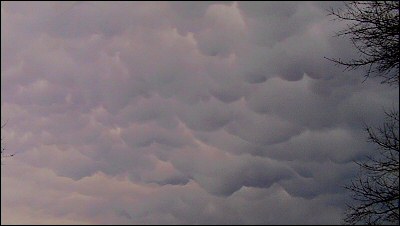

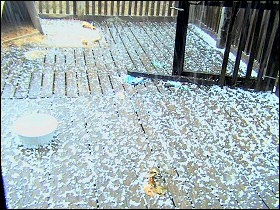
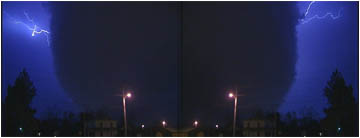
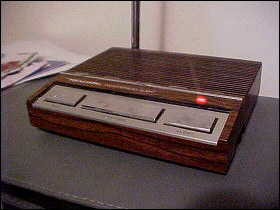
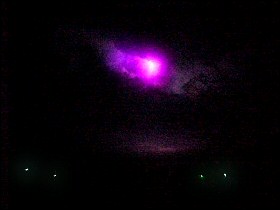 …
… 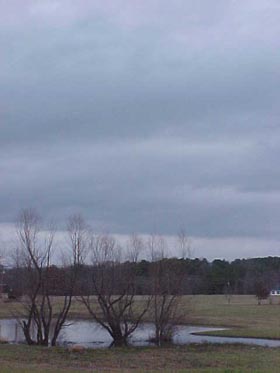
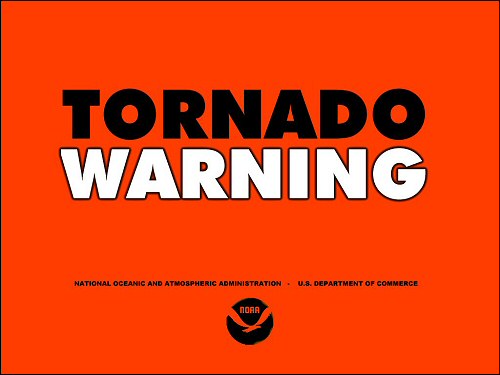
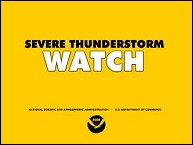
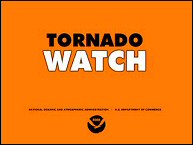 And then, before Forrest John, the voice of Fort Smith’s now-defunct National Weather Service office, had a chance to give me further occasion to shit myself, an almighty thunderclap and bolt of lightning hit somewhere very close to the house. And then the power was gone and the wind picked up and the hail began pelting the house and I was under some piece of furniture crying, despite being six or seven or so – past the generally accepted age at which a child, especially a male child, is expected respond that way.
And then, before Forrest John, the voice of Fort Smith’s now-defunct National Weather Service office, had a chance to give me further occasion to shit myself, an almighty thunderclap and bolt of lightning hit somewhere very close to the house. And then the power was gone and the wind picked up and the hail began pelting the house and I was under some piece of furniture crying, despite being six or seven or so – past the generally accepted age at which a child, especially a male child, is expected respond that way.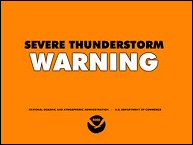 (By the way, the screens you see above are very accurate recreations I cobbled together in Paint Shop Pro after failing to find any evidence of the real key slides anywhere on the Internet. If anyone out there, especially fellow or former broadcast professionals with experience of working in Tornado Alley, can point me toward the real things, please give me a shout. I’m enough of a bad weather geek to have the originals scanned, digitally enshrine them and return the originals to you.)
(By the way, the screens you see above are very accurate recreations I cobbled together in Paint Shop Pro after failing to find any evidence of the real key slides anywhere on the Internet. If anyone out there, especially fellow or former broadcast professionals with experience of working in Tornado Alley, can point me toward the real things, please give me a shout. I’m enough of a bad weather geek to have the originals scanned, digitally enshrine them and return the originals to you.)





